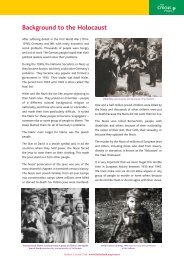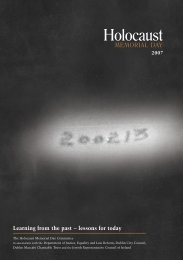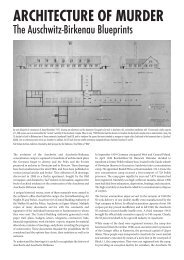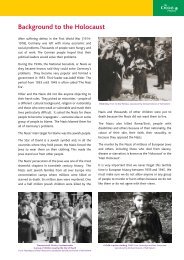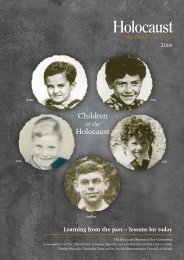19505_HMD_Cover:Layout 1 - Holocaust Education Trust Ireland
19505_HMD_Cover:Layout 1 - Holocaust Education Trust Ireland
19505_HMD_Cover:Layout 1 - Holocaust Education Trust Ireland
You also want an ePaper? Increase the reach of your titles
YUMPU automatically turns print PDFs into web optimized ePapers that Google loves.
<strong>Holocaust</strong> Memorial Day 2013<br />
In March 1942 every major Jewish community was still intact, and 80% of those European Jews who<br />
would be murdered in the <strong>Holocaust</strong> were still alive. By February 1943, just under one year later, 80%<br />
of those European Jews were already dead.<br />
Christopher R. Browning<br />
Killing sites/Einsatzgruppen<br />
Operation Reinhard<br />
Einsatzgruppen<br />
On 21 June 1941, Nazi Germany invaded the Soviet<br />
Union (Operation Barbarossa). Special killing<br />
squads called Einsatzgruppen followed the German<br />
army into Eastern Poland, Russia, Lithuania, Latvia,<br />
Estonia and other eastern territories occupied by the Nazis,<br />
where they operated hundreds of killing sites in these regions.<br />
Einsatzgruppen comprised police, local collaborators,<br />
SS units, as well as officers and soldiers of the German<br />
army. They murdered more than 1.5 million Jews in the<br />
forests, fields and cemeteries or herded them into ravines<br />
or pits which the victims had to dig themselves before they<br />
were shot. Einsatzgruppen killed mostly Jews, but also<br />
murdered Gypsies, communists and others. This “slow and<br />
cumbersome” method of eradicating the Jews as well as the<br />
face-to-face killing which was having a psychological effect<br />
on some of the killers, prompted the Nazis to find a more<br />
efficient solution to the elimination of the Jewish people –<br />
death by poison gas. Einsatzgruppen continued to operate<br />
in rural areas in parallel to the extermination taking place<br />
in the death camps.<br />
Belzec extermination camp stood at this place. A memorial has since been<br />
erected on this site<br />
Named after Reinhard Heydrich, this was the<br />
establishment of three death camps (killing<br />
centres) at Belzec, Sobibor and Treblinka, in<br />
which Jews were murdered by poison gas. Between<br />
March 1942 and August 1943 some 1,700,000 Jews,<br />
mostly from Poland,<br />
were murdered in gas<br />
chambers in these<br />
camps. They were<br />
dismantled on completion<br />
of their “function”<br />
and all traces of<br />
their existence were<br />
destroyed. The lands<br />
where they had stood<br />
were planted with<br />
forests, farms and<br />
grasslands.<br />
ORDINARY MEN<br />
It is everyone’s duty to reflect on what happened. Everybody must know, or remember, that when Hitler<br />
or Mussolini spoke in public, they were believed, applauded, admired, adored like gods. We must<br />
remember that these faithful followers, among them the diligent executors of inhuman orders, were not<br />
born torturers, were not (with few exceptions) monsters: they were ordinary men. Monsters exist but<br />
they are too few in number to be truly dangerous. More dangerous is the common men, the functionaries<br />
ready to believe and to act without asking questions, like Eichmann; like Hoss, the commandant of<br />
Auschwitz; like Stangl, commandant of Treblinka.<br />
Primo Levi<br />
9






